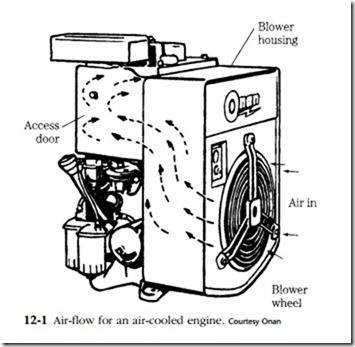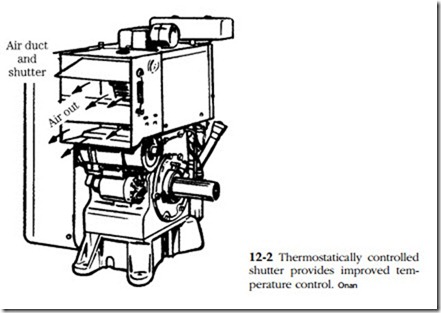Roughly 30% of the heat energy produced by combustion must be dissipated by the cooling system. In addition, the cooling system can be required to absorb heat from aftercoolers, engine and transmission oil coolers, hydraulic oil coolers, and other sources.
The great advantage of air cooling is its simplicity. There are no radiators, pumps, or hoses to add dead weight and eventually fail. On the other hand, the cooling fins and aluminum castings that promote heat transfer also transmit sound. Air-cooled engines are noisy. Nor does air cooling provide the precise temperature control necessary for good efficiency and low exhaust emissions. The centrifugal fan behaves like a turbocharger, pumping out too much air at high speeds and too little when the engine bogs under load.
Most air-cooled engines are small single- and twin-cylinder units developing less than 40 hp. But the concept is also applied to larger engines. Deutz builds a range of modular air-cooled engines of up to 500 hp, some of which are even used in marine applications. Most of the world’s armored vehicles are powered by air-cooled diesels.
Figure 12-1 shows the cooling arrangement for small utility engines. The flywheel- mounted fan generates air flow that is directed over the cylinder by means of shroud- ing. Few of these engines are equipped with temperature gauges, which is a serious oversight. The operator can measure oil temperature with a thermometer placed in the dipstick boss to a depth of about 5/16 in. below the end of the stick, but well clear of metal surfaces. Maximum permissible oil temperature is a judgment call, with one manufacturer suggesting that it should not exceed 210°F (99°C) above ambient.
The thermostatically controlled shutter used by Onan gives an idea of the normal range of air-outlet temperatures (Fig. 12-2). The thermostat, mounted in the air outlet, begins to open the shutter when temperature reaches 120°F (49°C) and extends fully at 140°F (60°C). A second thermostat shuts off fuel delivery when
outlet-air temperature reaches 250°F (121°C). It is fair to say that outlet-air temperature should not exceed 45°F above ambient under load.
Chronic overheating means that the engine is undersized for the application. Other than periodically cleaning the fins and checking the fit of the tin work, there is little a mechanic can do to improve cooling. A very light coat of dull black paint applied over bare metal on exposed surfaces makes a marginal improvement in radiation.

